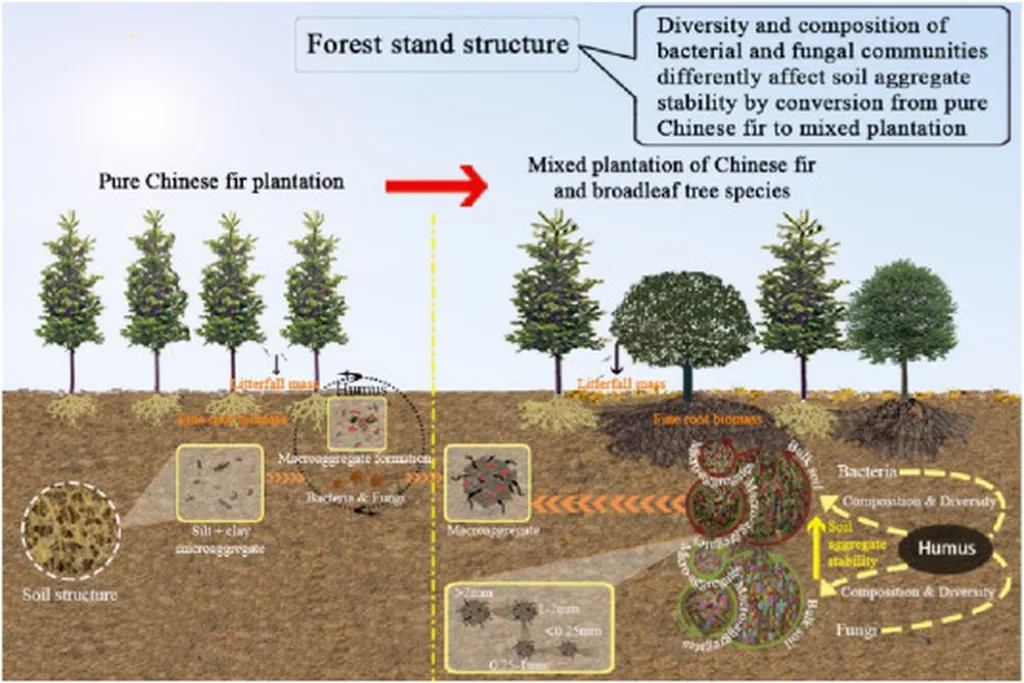In the lush forests of southern China, a groundbreaking study is reshaping how we understand and utilize one of the region’s most vital tree species: the Chinese fir (Cunninghamia lanceolata). Researchers, led by Zheyuan Wu from the Research Institute of Forest Resource Information Techniques at the Chinese Academy of Forestry, have developed a sophisticated biomass model that promises to revolutionize forest management and the energy sector. Their work, recently published in *Frontiers in Plant Science* (which translates to “Frontiers in Plant Science”), offers a nuanced approach to estimating above-ground biomass, a critical factor for sustainable forestry and bioenergy production.
The study leverages cutting-edge technology, specifically UAV-based LiDAR (Light Detection and Ranging) data, to create high-density point clouds and high-resolution spectral data. This technology provides an unprecedented level of detail for analyzing the 3D structure of trees. “By using UAV LiDAR, we can capture the intricate details of tree structures that were previously inaccessible,” Wu explains. “This allows us to develop more accurate models for biomass estimation.”
The research team collected measurements from 20,836 Chinese fir trees, categorizing them into five distinct growth stages. They compared four basic models and found that the Power Function model was the most accurate, particularly for estimating stem and bark biomass. To further refine the model, they introduced age groups as dummy variables, which significantly improved the model’s performance. “Incorporating age groups into the dummy model increased the R² value by an average of 2.6%,” Wu notes. “This enhancement is crucial for understanding the biomass allocation characteristics across different growth stages.”
One of the study’s key innovations is the use of a seemingly unrelated regression (SUR) model to address the inconsistency between the sum of individual biomass components and total biomass. Although this approach slightly reduced the fitting accuracy for individual tree components by an average of 2.5%, it provided a more comprehensive understanding of the interrelationships between different biomass components. “The SUR model offers a more holistic view of biomass distribution, which is essential for practical applications in forest management and bioenergy production,” Wu adds.
The implications of this research are far-reaching. Accurate biomass estimation is vital for sustainable forest management, ensuring that forests are harvested responsibly and that bioenergy production is optimized. “This study provides a robust framework for estimating aboveground biomass in Chinese fir forests across different growth stages,” Wu states. “It supports the sustainable use of these forests, which are crucial for both ecological balance and economic development.”
For the energy sector, this research offers a valuable tool for assessing the potential of Chinese fir forests as a renewable energy source. By understanding the biomass allocation characteristics and growth stages, energy companies can make more informed decisions about where and how to source biomass for bioenergy production. This not only enhances the efficiency of energy production but also promotes sustainable practices that benefit the environment.
As the world increasingly turns to renewable energy sources, the need for accurate and reliable biomass models becomes ever more critical. The work of Zheyuan Wu and his team represents a significant step forward in this field, providing a model that is both scientifically rigorous and practically applicable. Their research not only advances our understanding of Chinese fir forests but also paves the way for more sustainable and efficient bioenergy production.
In the broader context, this study highlights the potential of integrating advanced technologies like UAV LiDAR with traditional forestry practices. As Wu puts it, “The future of forest management lies in the fusion of technology and science. By leveraging these tools, we can achieve a more sustainable and productive use of our forest resources.”
The findings of this research are set to influence future developments in the field, encouraging further exploration of advanced technologies and innovative models for biomass estimation. As the energy sector continues to evolve, the insights gained from this study will be instrumental in shaping policies and practices that promote sustainable forestry and renewable energy production.

